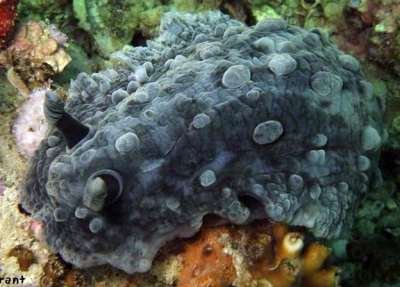
Dendrodoris warta
Marcus & Gallagher, 1976
Order: NUDIBRANCHIA
Suborder: DORIDINA
Superfamily: EUDORIDOIDEA
Family: Dendrodorididae
DISTRIBUTION
Known only from the Atlantic coast of Georgia, USA, and the west coast of Florida.
PHOTO
On an artificial reef, 10 miles off the coast of Clearwater, Florida, USA. 9+ inches long. 27 May 2005, depth 45-55 feet. Photo: Carol Grant
A large dendrodorid, known from very few records. It was described as having a dark brown background with tan to pinky-beige variably sized tubercles all over the mantle, but the photo here suggests it maybe more variable in colour. Tubercles vary in size, shape and distribution, being quite sparse in small animals and more crowded in larger ones. The rhinophores have a large translucent brown club, with white lamellae and tips, and adrak brown stalk. The underside of mantle is uniformly lighter than the dorsal surface. The egg ribbon is a ruffled orange spiral. Interestingly the animals reported on by Marcus & Gallagher were found were on oysters (Crassostrea ) feeding on an orange encrusting sponge. It is reported to reach a live length of 12 cm.
-
Marcus, Ev & Gallagher, S. B. (1976) A new species of Dendrodoris from Florida. The Veliger, 18(4): 353-356.
Rudman, W.B., 2005 (July 10) Dendrodoris warta Marcus & Gallagher, 1976. [In] Sea Slug Forum. Australian Museum, Sydney. Available from http://www.seaslugforum.net/find/dendwart
Related messages
Dendrodoris warta from Florida
July 10, 2008
From: Geoffrey H. Smith Jr.
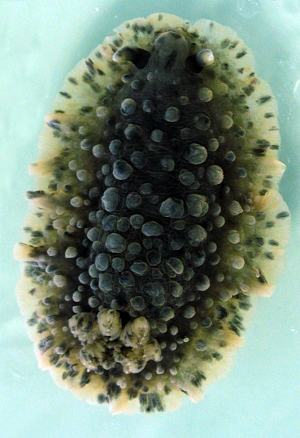
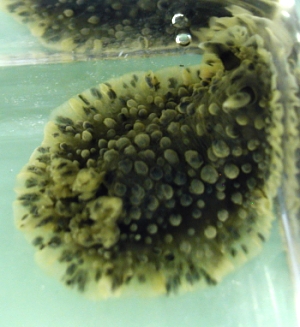
Concerning message #21641:
I have been meaning to send you some pictures of a few different nudibranchs I have found over the past several years while I was working on my undergraduate degree in marine biology at New College of Florida. This is one I had almost forgot about, but I found it going through some old photos. I believe it is some type of dorid nudibranch. It was found on the underside of a rock in an intertidal area. I believe the rock was covered in several species of sponges and colonial tunicates. Do you have any idea what species it is, even just a genus would be informative.
Locality: Island Park in Sarasota, 1-2 feet, Florida, United States, Gulf of Mexico, found in 2003 or 2004, intertidal, under rock. Length: approximately 2 inches. Photographer: Geoffrey Smith.
Thanks for any information you can provide.
Geoffrey Smith
geoffreyhsmith@gmail.com
Smith, G.H., 2008 (Jul 10) Dendrodoris warta from Florida. [Message in] Sea Slug Forum. Australian Museum, Sydney. Available from http://www.seaslugforum.net/find/21670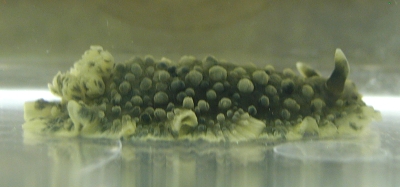
Dear Geoff,
This is Dendrodoris warta which has only been found so far in the southeastern corner of the USA. As you will see from reading earlier messages on the species, it has rarely been reported since it was originally described which is a bit surprising considering the relatively large size it can grow. Maybe its unattractive appearance has meant that it has seldom been photographed by divers.
Best wishes,
Bill Rudman
Re: The Elusive Warty Sea Slug
April 7, 2008
From: Kelly Kingon
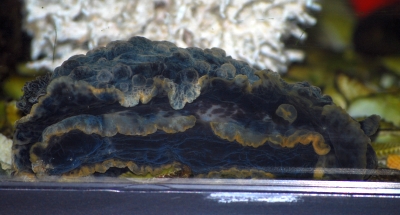
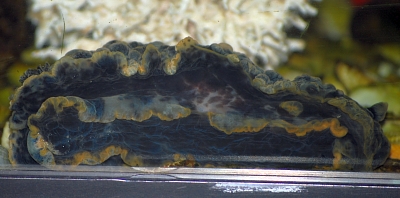
Concerning message #14223:
Hi,
So I finally found another Dendrodoris warta. This time at a different spot but probably only a few miles away. There were also Hypselodoris picta at this site which I have collected in the past as they are quite common around here at least as far as nudibranchs go. Anyway I decided to keep this D. warta as well for my fish tank in order to learn a little about its behavior and to be able to take some pics of it; once again I didn't have my camera underwater with me. Anyway here are a couple quick shots I took of its ventral side and as you can see, no white spots. Let me know if there is anything you would like pics of or information on. I'm not sure what it eats up here. I found it on the sand but there are a few sponges in my tank for it to try.
Locality: south of St. Teresa, 45 feet, Florida, USA, Gulf of Mexico, 02 April 2008, natural hard bottom ledge. Length: 6 inches. Photographer: Kelly Kingon.
Kelly Kingon
kingon@bio.fsu.edu
Kingon, K.C., 2008 (Apr 7) Re: The Elusive Warty Sea Slug. [Message in] Sea Slug Forum. Australian Museum, Sydney. Available from http://www.seaslugforum.net/find/21492Thanks Kelly,
I hope it can find a sponge to its liking in your aquarium. As you have probably gathered, our knowledge of the diet of most species is very poor, partly because identifying sponges is probably more difficult than identifying nudibranchs.
Your mention of H. picta being quite common sounds interesting. We have little information outside the Mediterranean on the food of this species [or group of species?] so photos of it on it food sponge, preferably feeding, and photos of its egg ribbon would be valuable.
Best wishes,
Bill Rudman
Re: The Elusive Warty Sea Slug
September 20, 2007
From: Jay Norman
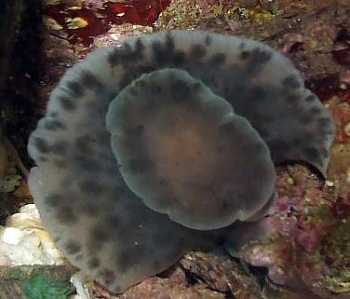
Concerning message #19770:
I have one in my home aquarium. Here is a picture of the mantle from underneath.
Jay Norman
whyme@inbox.com
Norman, J., 2007 (Sep 20) Re: The Elusive Warty Sea Slug. [Message in] Sea Slug Forum. Australian Museum, Sydney. Available from http://www.seaslugforum.net/find/20628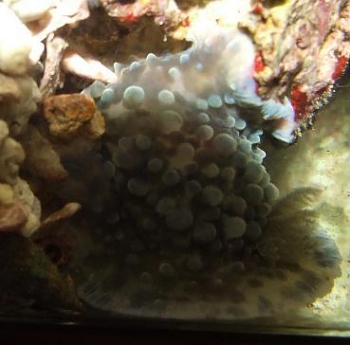
Dear Jay,
Thanks very much for sending this photo of the underside of Dendrodoris warta. It is certainly different from both the Indo-West Pacific species. If you have any locality data for your animal, and its length, it would be nice to include it in your message.
Best wishes,
Bill Rudman
Re: The Elusive Warty Sea Slug
March 28, 2007
From: Kelly Kingon
Concerning message #14223:
Hi,
I recently saw two of these Dendrodoris warta on a dive about 15 miles south of Carrabelle, Florida. I assume that I am identifying them correctly. They looked just like the pictures taken in Clearwater. They were both huge, at least for nudibranchs. One was about 10 inches long and the other was a couple inches shorter. They were approximately 2-3 inches wide. They were found on natural live bottom at a depth of about 65'. They were seen on Saturday, March 24, 2007. I also saw what I believe was a Hyselodoris picta nearby in the sand. It was between 3 and 4" long. Unfortunately my camera is broken at the moment. I would have loved to have some pictures of them. So I guess you can extend their range further up the Gulf! Very cool critters!
Locality: 15 miles south of Carrabelle, 65', FL, USA, Gulf of Mexico, 24 March 2007, natural live bottom and sand. Length: 10", 8", 3-4"
Cheers,
Kelly Kingon
zayla_21k@yahoo.com
Kingon, K.C., 2007 (Mar 28) Re: The Elusive Warty Sea Slug. [Message in] Sea Slug Forum. Australian Museum, Sydney. Available from http://www.seaslugforum.net/find/19770Dear Kelly,
Thanks for the record. When you get your canera going again perhaps you could go looking for it again. As I said in the earlier message, it would be nice to get a photo of the underside so we could compare it with similar-looking species from the Indo-West Pacific
Best wishes,
Bill Rudman
Dendrodoris warta - more photos
July 12, 2005
From: Carol Grant
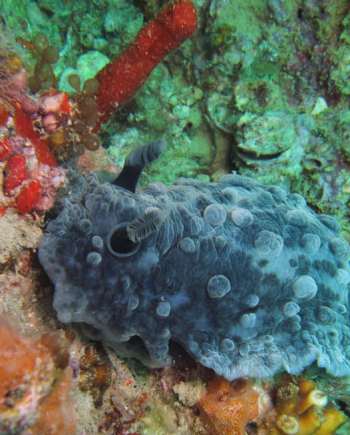
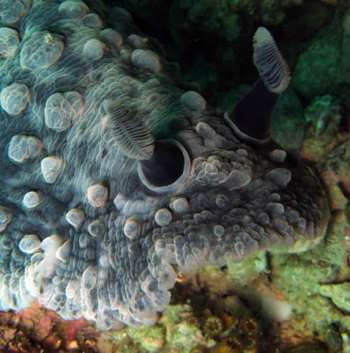
Hi Bill,
Thanks for your reply [#14223 ] It may not be "the" holy grail for slug guys, but maybe there are a number of "holy grails"???? That said, I bet he would be one. At least the research group that first documented him in 2004 at
Gray's Reef, Georgia, were quite excited!
Here are more pics. The color on these pics is very accurate to what the camera took (and what I saw). Only thing I did with these pics is take away some of the off color cast common to digital photos and I sharpened them. I did not crop or remove scatter as I usually would. I thought you could tell the size of the slug more with everything in tact. Viz was pretty poor, maybe 20 feet, maybe 15. Only used the internal flash so a couple still have lots of green shadow.
Carol
caroldive@mac.com
Grant, C., 2005 (Jul 12) Dendrodoris warta - more photos. [Message in] Sea Slug Forum. Australian Museum, Sydney. Available from http://www.seaslugforum.net/find/14249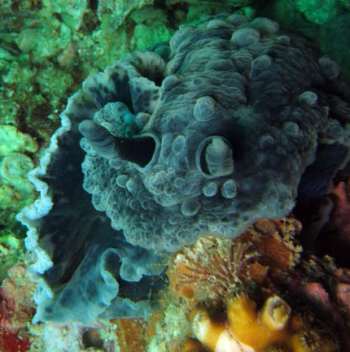
Thanks Carol,
This is a very valuable contribution. Measuring nudibranchs precisely is impossible because their length is very plastic, and can change considerably depending on whether they are resting or crawling. It is clealry one of the 'big' species of Dendrodoris. Don't feel bad about not photographing its underside - most of us don't. However in your photo alongside I can see a quite mottled pattern, quite similar to that on the dorsum.
Concerning its food, Marcus & Gallagher (1976) report that it was found in the field feeding on an orange sponge boring into oysters and specimens were kept alive in aquaria by adding oysters with the boring sponge. The bright orange faeces produced by the Dendrodoris confirming its choice of food.
Best wishes,
Bill Rudman
The Elusive Warty Sea Slug
July 11, 2005
From: Carol Grant

Here is one of the "holy grails" as I understand it for all slug hunters! Not being well versed in inverts myself I sat on these pics for a few weeks till I found out from the research co ordinator at Gray's Reef Nat'l Marine Sanctuary off the Georgia coast [Greg McFall], that what I had pictures of from offshore, Clearwater, Florida, was the elusive warty sea slug (Dendrodoris warta ). There are very few pics of this slug in existence.
Locality: On an artificial reef, 10 miles off the coast of Clearwater, Florida, USA. 9+ inches long.May 27, 2005, depth 45-55 feet. Photo: Carol Grant
It is a very large nudibranch, this one pictured was 9+ inches long and about 4 inches wide. It appeared to be feeding on something. Found on an artificial reef, 10 miles off the coast of Clearwater, Florida.Dendrodoris warta has previously been spotted at Gray's Reef National Marine Sanctuary, Georgia, and as far as I understand it that is the place it was first photographed and videoed by researchers.
I dive the Gulf off Clearwater a lot but do not recall seeing this fellow on any of my previous dives. It is a very cool thing to behold and could even make a fish-lover like me lean over towards the slug world! Funny enough I found him on my first dive with my new Fuji F810........ I was just glad to find something that didn't move to practice on!! Taken with internal flash, on auto I believe, I was being very timid that day!
Hope you find it as interesting as I do, as I understand the range of this creature is still being documented.
Carol
caroldive@mac.com
Grant, C., 2005 (Jul 11) The Elusive Warty Sea Slug. [Message in] Sea Slug Forum. Australian Museum, Sydney. Available from http://www.seaslugforum.net/find/14223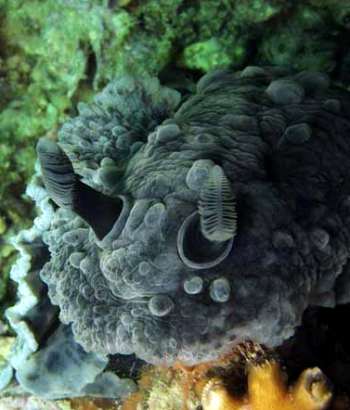
Dear Carol,
This is indeed an interesting find - though 'holy grail' may be a bit extreme. You wouldn't by chance have a photo showing its underside would you? Why I ask is that it is quite similar to too large Indo-West Pacific species, D. carbunculosa and D. tuberculosa, and one simple way to distinguish them is that D. tuberculosa has large white spots on the underside of the mantle. It would be interesting to know if D. warta has spots or not.
We have a record of D. carbunculosa from the Pacific coast of Costa Rica on the Forum [message #2954] and I wondered at the time whether D. warta was the same species, as our knowledge of the living animal was not great. Your photos suggest it is different from both those big Indo_West Pacific dendrodorids, but the rhinophore shape suggests a link
Thanks for thinking of us,
Bill Rudman
